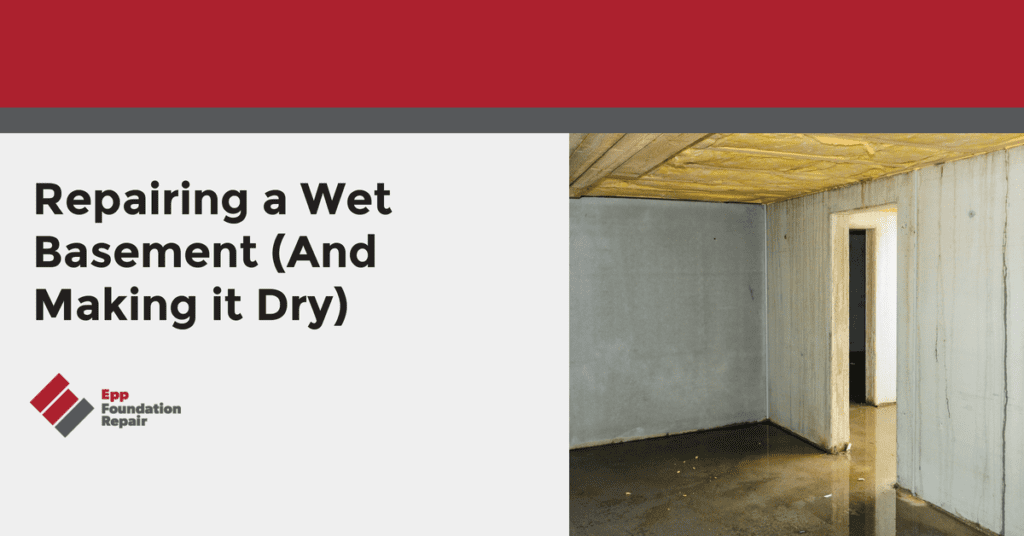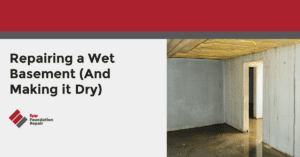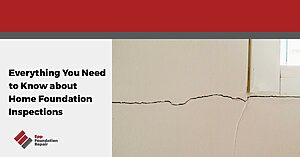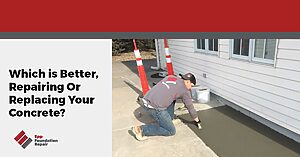Do you have a wet basement?
Are you looking for wet basement repair? Wondering why your basement is damp, and what you can do about it? Whatever you do, don’t leave your soggy basement as is! If water is getting into your basement, it may be because of exterior issues, but a huge cause could be from foundation problems.
In this article we’re going to talk about the causes of wet basements, the kind of damage they can create, and how you can turn wet basements into dry, comfortable living spaces. So, let’s talk first about what causes a wet basement.
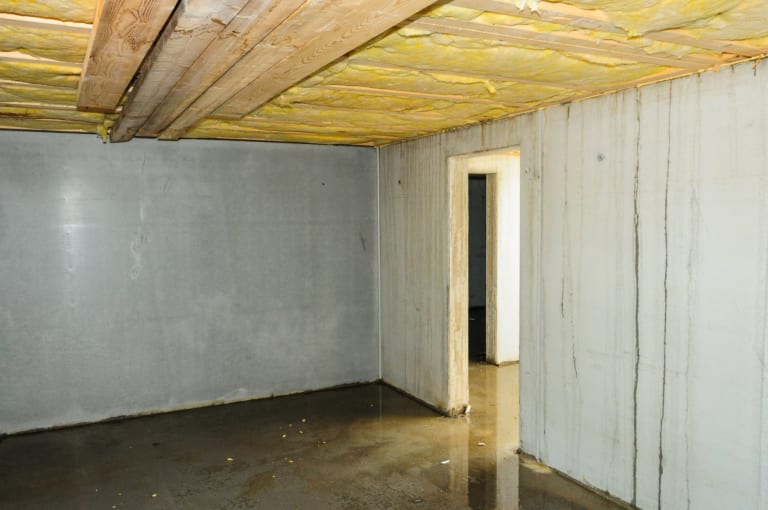
What causes a wet basement?
Basements get wet for a variety of reasons including:
- Condensation – Condensation (also called “sweating”) is when water vapor becomes a liquid. This might happen when warm air hits cool foundation walls, or the uninsulated cold-water pipes in your basement. Condensation looks like little droplets or puddles, and makes your basement damp and uncomfortable.
- Runoff – When it rains or snows, you may notice moisture building up in your basement or crawlspace. This happens because the water sinks through the soil and stops near the foundation’s base. Hydrostatic pressure forces the water through cracks and gaps in the basement walls. Water can also intrude through walls via capillary action. This is when a liquid is able to flow in narrow spaces without any assistance from gravity.
- Subsurface runoff/high water tables – If you notice wet-basement symptoms that look like water runoff (which is when water “runs off” or slides off a land surface), but they occur all the time, you’re most likely dealing with high groundwater. Check with your city if your home is in an area with a high water table. A water table is defined “as a boundary between the water-saturated ground and unsaturated ground.” A high water table is when an area receives more water than it’s able to drain off.
- Infiltration of water caused bowing basement walls – A foundation wall can curve inward, forming a “bow”, when there is excessive lateral pressure from the soil surrounding the walls. Water and moisture will find their way inside your basement using the bowed wall as an entry point. Water will always find the point of least resistance and use any crack, joint, or opening to infiltrate your home. Water can also infiltrate your basement via wall cracks, floor cracks, and cove joints (the area where the foundation wall meets the floor).
- Cracks in basement walls – Water can easily use cracks to enter your basement.
- Basement window leaks – If a window well doesn’t drain properly, is clogged, or the stones in the window well don’t provide the proper drainage, water can pool inside the well and eventually you’ll have a leak.
- Leaks around basement pipes – If you have pipes that run through your basement walls, you may notice signs of leaks and improper sealing at the penetration area.
- Water seeping through cove joints – A cove joint is where the foundation wall meets the floor. Again, water finds the points of least resistance and will enter your basement.
- Sump pump not draining – A sump pump sits in a sump “pit” – usually in your basement or crawlspace – and acts as a drain. It removes groundwater from underneath your home, and without it, water from below the ground or from heavy precipitation would cause your basement, or even your home’s main floor, to flood. The sump “pit” collects the water, and the sump pump carries it out of the basement.
- Floor drain backing up – A floor drain usually sits at the lowest point of the basement floor and acts as an outlet for unwanted water. It helps collect water from heavy rainfall, condensation from an HVAC unit, or a leaking water heater. The floor drain will either connect to the sewer system, or lead back to the sump pump. If your basement floor is lower than the main sewer line, an ejector pump will be connected to the drain in order to shoot the water up and out through the line. A clogged drain will lead to improper drainage and flooding.
- Seepage over the top of a wall – Water can seep over the top of your basement wall due to water sliding toward the house, instead of away from it. Dirt must be properly graded, meaning sloped, away from your home so that water can drain.
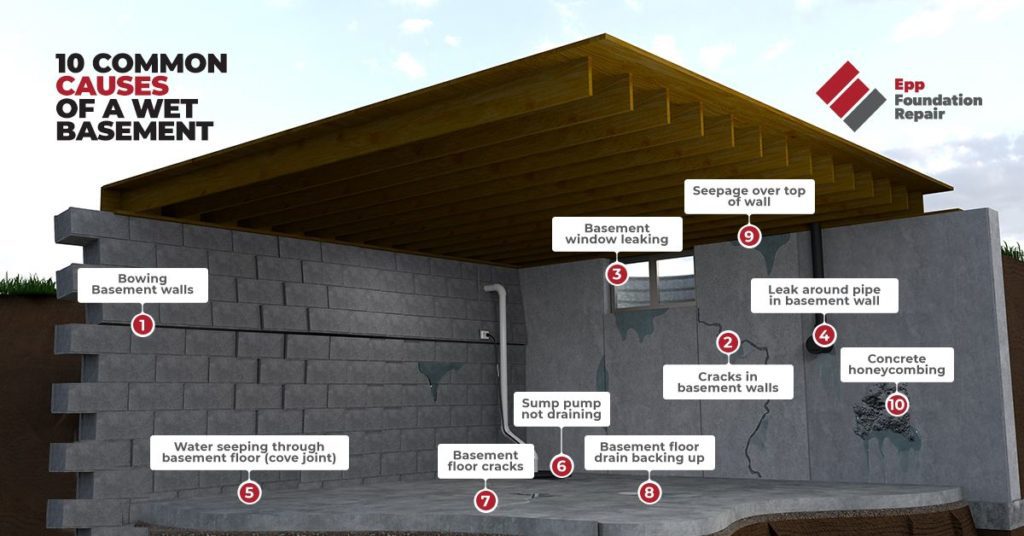
Well, that’s how water enters your basement. So what happens if you don’t do anything about it? Let’s go over that now.
Why you don’t want a wet basement
Water in your basement could mean you are one heavy rain away from a flood. In addition, a wet basement could be a sign of serious foundation problems. If your basement is a living space, you could lose furniture, electronics, and personal items due to water damage. Wet basements also can cause:
- Mold
- Musty odors
- Allergens (affecting existing allergies or even creating new allergies)
- Wet basements are also a sign of foundation damage and put you at risk for basement flooding
So how do you repair a wet basement? Can you do it yourself, or do you need the professionals? We have broken it up into two sections; DIY repair methods and professional methods.
Learn more about: What To Do When Basement Floods
How to repair a wet basement: DIY solutions
Are there solutions that you can do from home, without the need for professionals? There are a few, but they are mostly temporary and may not solve the problem permanently.
- Gutter extensions and splash guards – Gutter extensions are added onto downspouts that dump water less than 5 feet away from your house. They guide water away from your home, preventing it from seeping into the soil near your foundation walls. Splash guards prevent water from overshooting your gutter.
- Plug gaps – If you see water or moisture seeping through cracks, you can plug the openings yourself with hydraulic cement polyurethane caulk for less than $20. You can also plug leaks around pipes. If water is coming up through the floor or at the cove joint, groundwater will get through and plugs won’t solve the issue.
- Reshape the landscape – When landscaping slopes toward your basement, water will flow toward your house and build up near your walls. You can create a berm, a mound of dirt that will keep moisture away from specific areas, or a swale, which is a wide, shallow ditch used to collect water and channel it away from your home. The soil around your house should slope away from it.
- Unclog footing drains – Footing drains are underground pipes that were installed at the time of construction in order to carry away water from the foundation. To check if you have footing drains, look for a drain in the basement floor, or a cleanout pipe capped a few inches above the floor. If you have these, hair, oil, or other waste may clog the line. A plumber’s snake auger may be able to clear out any clogs.
These solutions are easy to do at home, but will they be a permanent solution? Most likely not. Professionals, on the other hand, can offer waterproofing solutions that last.
Read also: DIY Foundation repair methods
How to repair a wet basement: Professional solutions
If you want to make sure your problems are over and done with, get in touch with experts who know what they are doing. Professional basement waterproofing solutions include:
Sealing/waterproofing walls
1. Vapor Barrier – A vapor barrier is any material used for damp proofing. This is usually a plastic (polyethylene) or foil sheet that can resist moisture diffusion through the wall.
2. Exterior Waterproofing Membrane – A waterproofing membrane keeps water away from the foundation wall and prevents water or moisture from getting inside. It’s applied to the outside of the basement wall, and below the ground.
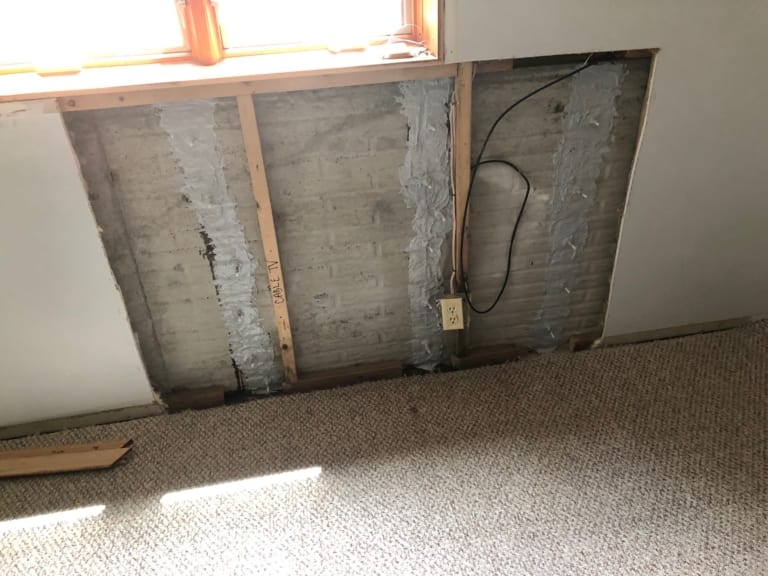
3. Epoxy Crack Injection – Professionals can fill in cracks from front to back using an epoxy or polyurethane substance.
Structural support for basement walls
- Wall Plate Anchors – Wall plate anchors stop the inward movement from a bowing wall. A wall anchor does not add additional stress to the home because the plate anchor is placed outside in the soil. Anchors need a minimum of 10 feet of yard in order to be installed. Other anchors include:
- C-Channel Anchors – C-Channel anchors are for “sheering,” which is inward deflection at the bottom of the wall near the floor. The channel goes up to around 12 inches above the nut (exterior rod).
- Helical Tiebacks – Like corkscrews, tiebacks are installed by rotating the anchor into the ground. They provide opposite pressure that cancels out the hydrostatic pressure which caused the wall to bow in the first place.
- Carbon Fiber Straps – Carbon fiber straps are tied to the foundation base and house framing. Epp Foundation Repair usually uses straps when there is limited space outside of the wall, or the yard is not long enough.
- Steel I-Beams – Steel I-Beams are a structural brace system that counteracts movement stress, such as constant soil pressure, which can cause bowing and cracking. They can even correct the wall’s alignment over time.
- Steel Push Piers – Push piers are a foundation underpinning solution and can help with foundation settlement, one of the causes of wet basements. In fact, push piers can permanently stop foundation settlement.
Draining the water from your basement
- Sump Pump with Battery Backup – A sump pump is a fixture that usually sits in a home’s basement or crawlspace and removes groundwater from underneath the house. A battery backup will help the sump pump continue running in case there’s a power outage (perhaps due to flooding).
- Drain Tile (that ties into the sump pit) – Drain Tile collects water and leads it to the sump pit, where the water is gathered and pumped out.
- Window Well Drainage – Water should be able to properly drain out of the basement window well. If not, it can build up and leak through the window into the basement. If you notice water building up in your window well, you might have a problem with drainage.
- Install Curtain Drains – A curtain drain (similar to a French drain), is a shallow trench usually 1 to 2 feet deep and 8 to 18 inches wide. It’s filled with gravel and perforated piping that intercepts water uphill and channels it away from your house.
Who can repair a wet basement?
As we mentioned earlier, the DIY solutions are simple to complete but are only temporary solutions. The professional solutions we mentioned are not things you can just pick up and complete yourself, and that’s where Epp Foundation Repair comes in. We serve Lincoln, Omaha, Grand Island, Kearney, NE and more with basement waterproofing services. Call us to schedule an inspection and receive an estimate based on your needs.

